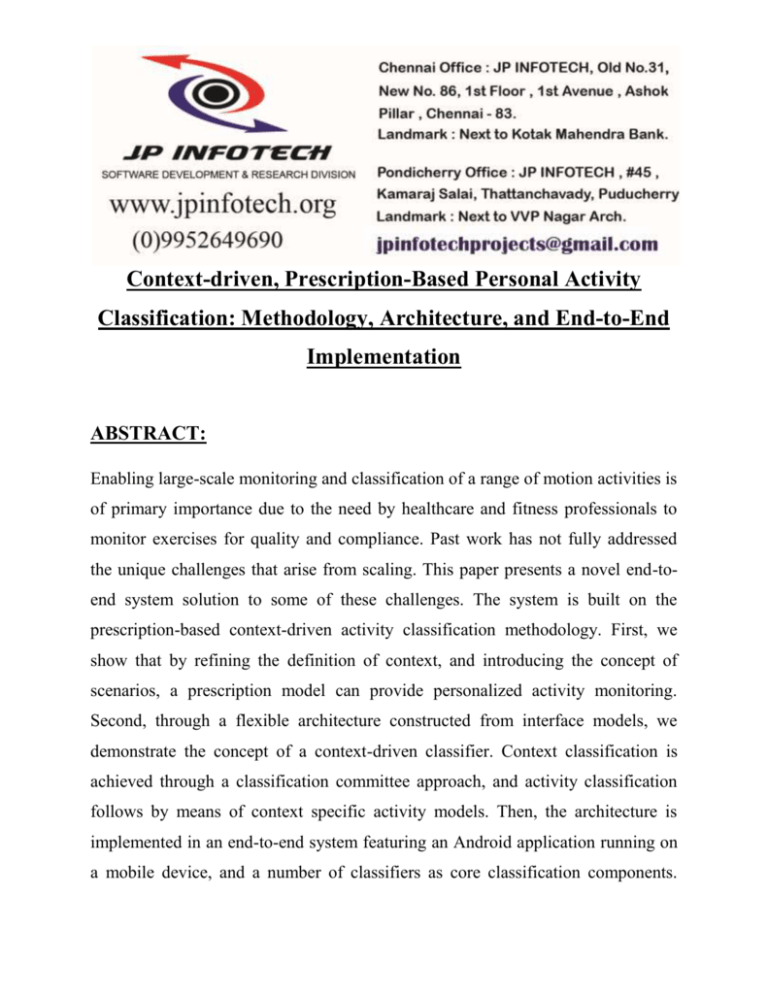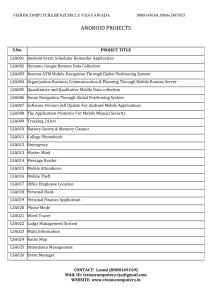Abstract
advertisement

Context-driven, Prescription-Based Personal Activity Classification: Methodology, Architecture, and End-to-End Implementation ABSTRACT: Enabling large-scale monitoring and classification of a range of motion activities is of primary importance due to the need by healthcare and fitness professionals to monitor exercises for quality and compliance. Past work has not fully addressed the unique challenges that arise from scaling. This paper presents a novel end-toend system solution to some of these challenges. The system is built on the prescription-based context-driven activity classification methodology. First, we show that by refining the definition of context, and introducing the concept of scenarios, a prescription model can provide personalized activity monitoring. Second, through a flexible architecture constructed from interface models, we demonstrate the concept of a context-driven classifier. Context classification is achieved through a classification committee approach, and activity classification follows by means of context specific activity models. Then, the architecture is implemented in an end-to-end system featuring an Android application running on a mobile device, and a number of classifiers as core classification components. Finally, we use a series of experimental field evaluations to confirm the expected benefits of the proposed system in terms of classification accuracy, rate, and sensor operating life. EXISTING SYSTEM: The proliferation of powerful mobile devices, along with the rapid advance in microelectronics, has brought micro-electromechanical system inertial sensors, low-power processors, ubiquitous computing, and reliable global data networks. This enables advances toward solving urgent problems in health and wellness promotion, diagnostics, and treatment of conditions. In particular, the integration of the state of the art in sensor technology, signal processing, and mobile computing can now enable large-scale monitoring and classification of a range of motion activities, providing evidence-based tools to monitor patient physical exercises for quality and compliance. DISADVANTAGES OF EXISTING SYSTEM: First, domain experts such as clinicians and fitness trainers prescribe exercises on a daily basis, but the quality and quantity performed by subjects are not monitored. Second, in large-scale deployments, domain experts come from diverse backgrounds with unique sets of activities of interest. Third, non-engineering domain experts do not accept complex classification systems requiring their input on training and classifier selection A large body of work has focused on the accurate detection of physical activities. However, enabling monitoring in large, diverse user communities has not been addressed. PROPOSED SYSTEM: To achieve the goal of enabling large-scale monitoring and classification, we propose a novel end-to-end system that provides context-driven personalized activity classification following a prescription model. Each of the aforementioned unique challenges is addressed in the following novel ways: 1) to allow seamless monitoring of prescribed physical exercises for quality and compliance, we present a prescription service-based methodology; 2) since the diverse user communities require personalized activity monitoring, we propose a context-driven approach where the context is redefined from previous work, and scenarios are defined as a natural extension; 3) a flexible architecture is crafted to provide the roadmap to an end-to-end system, with a management application tailored toward domain experts such as doctors, and a physical packagecontaining sensors bundled with a mobilebased client targeting end users ADVANTAGES OF PROPOSED SYSTEM: 1) the ability to accurately detect context using multiple sensing modes and machine learning. 2) The use of context to restrictively select activities needing classification, reducing the overall classification complexity and improving classification accuracy, speed, and energy usage. 3) The ability for experts from different domains to individually prescribe sets of physical activities of interest under different environments. SYSTEM ARCHITECTURE: SYSTEM REQUIREMENTS: HARDWARE REQUIREMENTS: System : Pentium IV 2.4 GHz. Hard Disk : 40 GB. Floppy Drive : 1.44 Mb. Monitor : 15 VGA Colour. Mouse : Logitech. Ram : 512 Mb. MOBILE : ANDROID SOFTWARE REQUIREMENTS: Operating system : Windows XP/7. Coding Language : Java 1.7 Tool Kit : Android 2.3 ABOVE IDE : Eclipse REFERENCE: James Y. Xu, Student Member, IEEE, Hua-I. Chang, Chieh Chien, William J. Kaiser, Senior Member, IEEE, and Gregory J. Pottie, Fellow, IEEE, “Contextdriven, Prescription-Based Personal Activity Classification: Methodology, Architecture, and End-to-End Implementation”, IEEE JOURNAL OF BIOMEDICAL AND HEALTH INFORMATICS, VOL. 18, NO. 3, MAY 2014.









